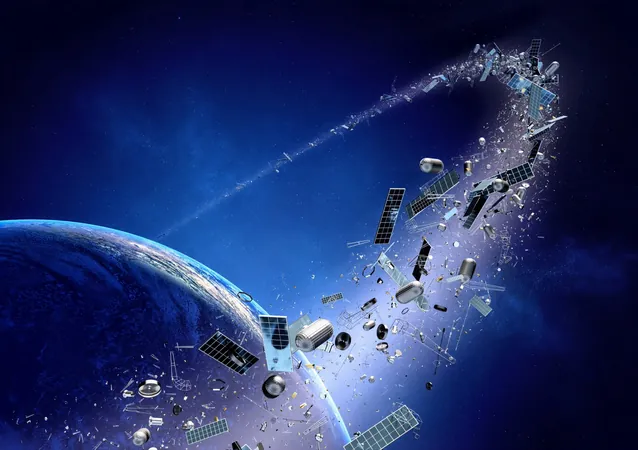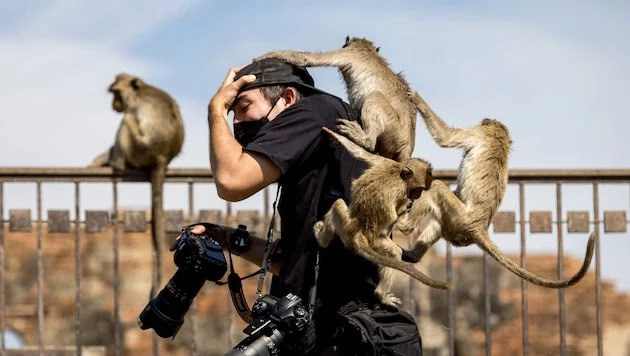
The Alarming Rise of Space Junk: Are We at Risk of Kessler Syndrome?
2025-01-05
Author: Ming
What is Low Earth Orbit (LEO)?
Low Earth Orbit is an area that extends from about 100 to 1,200 miles (160 to 2,000 kilometers) above Earth’s surface. LEO is a hotspot for satellite operations because it allows for faster communication and lower costs for launching payloads into space. Most notably, the International Space Station (ISS) orbits at around 250 miles (400 kilometers) in LEO, serving as a hub for scientific research and international cooperation.
Currently, there are over 10,000 active satellites in orbit, with a significant portion—around 6,800—belonging to Elon Musk's Starlink network. As companies like SpaceX and Amazon ramp up plans to deploy thousands of additional satellites, the risks of collisions increase dramatically.
What is Kessler Syndrome?
The concept of Kessler Syndrome, introduced in 1978 by NASA scientists Donald Kessler and Burton Cour-Palais, theorizes that as the number of satellites and debris in orbit increases, the likelihood of collisions will also rise. This could trigger a snowball effect of collisions that creates even more debris, subsequently making low Earth orbit hazardous for existing and future satellites.
Experts like John L. Crassidis, a leading space debris researcher, cautioned that if collisions in LEO escalate, it could become impossible to safely launch new satellites into orbit. The ramifications of Kessler Syndrome are severe; it could jeopardize vital technologies such as GPS, communications, and weather forecasting, which rely on satellite functionality.
The Growing Threat of Space Debris
Since the dawn of space exploration in 1957, humanity has experienced over 650 fragmentation events—collisions, explosions, and deliberate destruction of satellites included. One particularly notorious incident in 2021 involved Russia testing a missile that destroyed one of its own satellites, creating over 1,500 pieces of detectable debris.
Bill Therien from ExoAnalytic Solutions noted the ongoing challenge of monitoring this debris, which ranges in size from small fragments akin to softballs to larger pieces comparable to car doors. Tracking these smaller pieces is a formidable challenge, further complicating debris mitigation efforts.
Consequences and Future Risks
The congestion of space poses direct dangers to astronauts aboard the ISS and disrupts vital technologies that modern society depends on. For instance, the ISS has had to perform evasive maneuvers multiple times to avoid potential collisions with debris. In one alarming recent event, debris was tracked to within 2.5 miles of the ISS, demonstrating how urgent this issue is.
Should significant collisions occur, critical services could be disrupted, leading to failures in GPS systems, internet services, and telecommunications—essentially bringing a halt to many facets of daily life.
Mitigation Efforts and the Need for Regulations
Efforts to tackle the space debris crisis are gaining momentum. The European Space Agency (ESA) has partnered with the Swiss startup ClearSpace to devise initiatives like Clearsat-1, aimed at capturing and deorbiting defunct satellites. Another innovative technology under development is drag sails, which can hasten the descent of defunct objects into Earth’s atmosphere.
Despite these initiatives, tracking and mitigating space debris presents immense challenges. According to the ESA, there are approximately 40,500 pieces of debris larger than 10 centimeters, along with millions of smaller fragments that currently defy detection.
Experts stress the urgent need for international collaboration to establish credible regulations governing space activities. The United Nations’ Pact for the Future seeks to provide frameworks for traffic management in orbit, but enforcement remains a critical gap. Dr. Vishnu Reddy from the University of Arizona emphasizes that establishing norms and guidelines is essential for enhancing space safety.



 Brasil (PT)
Brasil (PT)
 Canada (EN)
Canada (EN)
 Chile (ES)
Chile (ES)
 Česko (CS)
Česko (CS)
 대한민국 (KO)
대한민국 (KO)
 España (ES)
España (ES)
 France (FR)
France (FR)
 Hong Kong (EN)
Hong Kong (EN)
 Italia (IT)
Italia (IT)
 日本 (JA)
日本 (JA)
 Magyarország (HU)
Magyarország (HU)
 Norge (NO)
Norge (NO)
 Polska (PL)
Polska (PL)
 Schweiz (DE)
Schweiz (DE)
 Singapore (EN)
Singapore (EN)
 Sverige (SV)
Sverige (SV)
 Suomi (FI)
Suomi (FI)
 Türkiye (TR)
Türkiye (TR)
 الإمارات العربية المتحدة (AR)
الإمارات العربية المتحدة (AR)